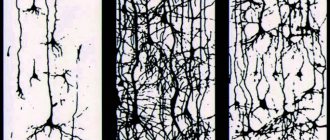Expressive vocabulary of colloquial use
The semantic range of ELE in colloquial use is quite wide: from (a) units with “full-fledged” denotative-significative content, often without formal indicators of expressiveness, located on the border with non-expressive, nominative, LE and often receiving unequal stylistic and emotional-evaluative interpretations in explanatory dictionaries (these are, as a rule, inanimate nouns, adjectives, verbs, adverbs), up to (b) units with vague or even “empty” denotative-significative content, “tied” to a certain emotional communicative situation and, as a result, on the border with interjections . Let us give examples of more or less semantically close LEs with their stylistic and emotional-evaluative marks from the same dictionary - “Explanatory Dictionary of the Russian Language” by S. I. Ozhegov and N. Yu. Shvedova, 1997 edition (hereinafter referred to as SOSH):
( a) sloppiness
colloquial, contemptuous, similar in structure and similar in semantics
,
rotozeystvo bungling
,
superficiality
are recorded in the dictionary only with the mark colloquial, cf.
corresponding generating words: slob
,
rotozey
, disapproval,
bungler
, contempt,
superlative
, colloquial;
other examples: anonymous letter
'an anonymous letter informing about someone.
sth. offensive, unpleasant, compromising' colloquial, disapproving, but fake
'false, forged document' - only a mark colloquial,
forgery
'a forged thing, imitation' - without a mark;
conspiracy
'an agreement as a result of negotiations' is usually disapproved, but
the transaction
'unseemly, reprehensible conspiracy' - without marking;
Manilovism
is disapproved, but
Oblomovism
,
Khlestakovism
are without labels (by the way, the suffix -
shchin -
in such LE V.V. Vinogradov classified it as expressive);
(b) nonsense
decomposition
'nonsense, nonsense', colloquial
nonsense.
'something senseless, absurd, incoherent', colloquial
nonsense.
'absurdity, stupidity, nonsense'; nonsense
colloquial
1. 'Nonsense, trifles, absurdity' (Great all kinds of
nonsense .) .
2. 'About something. insignificant, insignificant” (
“
Did you cut yourself badly?
”
–
“
Nonsense! ” )
;
nonsense
colloquially 'nonsense, absurdity';
nightmare
in meaning
a tale 'about something that manifests itself strongly or about a large number of someone.' simple, usually unapproved. (They spent money -
a nightmare !; And they threw away unnecessary things - just a nightmare! ) , and is also used as an interjection
(It’s cold outside
-
a nightmare! )
;
horror
in meaning
tale 'about something. amazing, unusual in its positive or negative properties, as well as about a large number of someone-something', colloquial. (cf. dialect contexts: It’s terrible how dirty their house is!
/
I don’t want to go there
;
He
[the groom]
bought so many balloons for the wedding!
/
Horror! ); trouble
in meaning
tale 'very much' is simple. (People there are
a disaster !) ;
in dialect speech it is used as an interjection (But recently there were so many mushrooms / they were carrying them all summer / it’s just
a disaster !) . I note that in different dictionaries the same word may have different interpretations in terms of their expressive and stylistic potential, but the corresponding material is not given here
1. Discussion points in the interpretation of expressiveness
as categories of lexicology
There are certain difficulties in interpreting the expressiveness of vocabulary as a category in terms of its semantics. This can be explained by a number of reasons.
Firstly, in the cognitive aspect, ELEs represent the results of both logical and emotional-psychic activity of consciousness in their integrity. In lexicology (semasiology and onomasiology), they (results) are called the terms denotative-significative (objective) and connotative (subjective) content (meaning, semantics) of the word. But the distinction between these two heterogeneous parts of a single, indivisible essence - the lexical meaning (hereinafter - LZ) of a word - does not have sufficiently convincing criteria and is often subjective in nature. Thus, it is known that philosophers, and after them linguists, divide assessments represented by words into logical and emotional: the former are referred by linguists to the denotative-significative part of the word’s meaning, the latter – to the connotative. Wed. the following oppositions of words with the same root and different roots with the semes 'logical assessment (positive or negative)' - 'emotive assessment (positive or negative)': kind
,
kindness
-
kindest
,
good-natured
;
angry
,
anger - feisty
,
spiteful
,
spiteful
,
villain
;
stupid
–
stupid
,
stupidity (Don’t tell me these
nonsense ; “
What if everyone finds out about your departure
?” - “
Nonsense !” )
;
mediocre
–
mediocrity
;
tasty – yummy
;
fragrant
-
smelly
,
fetid
;
quarrel
,
scandal
-
commotion
,
bazaar
,
bedlam
,
farce
,
benefit
irony,
circus
,
chaos
joke,
clamor
.
In the same way, this “high degree of manifestation of a characteristic of an object, phenomenon” can be qualified as significative and connotative. Wed. the following oppositions of words: with the general semes 'very hasty work': rush - race
,
fever
,
fever
,
storming
;
with the archiseme 'strong in the degree of its manifestation' strong - hellish
,
devilish
,
devilish
,
monstrous
,
terrible
,
insane
,
idiotic
(pain, tenderness, pride, speed, appetite, hunger, cold, weather, wind);
with the archeme 'a large number of homogeneous objects' many, many
-
an avalanche
(of feelings, questions, purchases), 'many faces' -
a constellation of fools
,
slackers
,
denim creatures
, 'many natural facts' -
a herd / herds of cornflowers
,
fir trees
,
clouds
,
butterflies.
Secondly, imagery as one of the components of meaning is also characteristic of words with denotative semantics and words with connotative semantics. Wed. pairs of cognate words with nominative and expressive meanings: serpentine
'spiral-curved tube' –
snake-house
'evil people gathered together, warring with each other';
petrified
(bones) –
petrify
(from grief);
awkward
'with shortcomings, internal flaws' -
awkwardness
(of life) (
He
[Yura]
was used to these changes, and in an atmosphere of eternal
awkwardness [in the family]
the absence of his father did not surprise him
(B. Pasternak. Doctor Zhivago));
to be nervous is a hassle;
whirl (about dust, snow) – dial.
swirl
'quickly walk, run, hurry'
(Look how the grandmother
swirls !) .
Consequently, the problem of finding criteria for classifying the named entities to the denotative-significative and connotative parts of LP words remains. In addition, the opinion is expressed that, apart from the suffixes of subjective assessment, there are no other “own means” (not counting stylistic figures and speech techniques) of expressiveness. [Telia 1991b: 33]. In his earlier monograph, V. N. Telia also emphasizes “tropomorphic and word-formative methods of forming expressive coloring,” and at the same time asserts that the “dominant role” in the creation of expressive coloring “belongs to metaphor as the simplest in composition, and therefore unmistakably the perceived technique of rethinking and strengthening the figurative signal” [Ibid: 1986: 71]. With the opinion of V. N. Telia on the “dominant role” of metaphor in the creation
,
the generation of
an “expressive effect”, of course, one cannot but agree.
Her works devoted to the expressive semantics of vocabulary and phraseology are a brilliant substantiation of this position. However, the opinion about the absence of “own means” of
expressiveness, except for suffixes of subjective assessment, is controversial.
Thirdly, those features that are involved in the generation of expressiveness belong to the connotative part (connotation) of the lexical meanings of words. It is debatable, in our opinion, the widespread assertion that connotation, and therefore expressiveness, is additional content (my disposition - N.L.
) words, “its accompanying semantic or stylistic shades that are superimposed on its basic meaning” [Akhmanova 1966: 203–204], as well as the statement that “the fund of expressive language means is additional (my discharge -
N. L.
) in relation to neutral commonly used ones, by its very idea it is configured for rarer use: expressiveness “is directly proportional to the unusualness, non-standardity, rarity of a word, phrase, morpheme, construction” [Matveeva 2003: 404].
The idea of complementarity, “non-principality” of connotation in the structure of a language word is demonstrated by the corresponding terminology introduced into lexicology from linguistic stylistics: expressiveness is called a shade of meaning
,
coloring
,
coloring
,
halo
, thereby the interpretation of expressiveness is taken from the systemic semantic channel into the linguistic-stylistic sphere.
Fourthly. ELE are stylistically marked (significant, colored). Discussion is raised by the question of the status of the stylistic property of ELE: some linguists identify stylistic marking as a component (“style component”, according to Matveeva) of the meaning of ELE, for example, V. N. Telia [Telia 1991a: 40–41], T. V. Matveeva [Matveeva 2003: 112]; other researchers do not include stylistic coloring in the meaning, calling it significance, for example, L.M. Vasiliev [Vasiliev 1985: 5]. And E.R. Kurilovich believes that “expressive forms and stylistic options <...> could be combined under the general term stylistic in the broad sense of the word” [Kurilovich 1955: 76]. As is known, even Sh. Bally, who laid the foundations of expressive stylistics, considered its subject “expressive facts of the language system from the point of view of their emotional content, that is, the expression in speech of phenomena from the field of feelings and the effect of speech facts on feelings” [Bally 2001: 33] . Consequently, the problem of distinguishing expressiveness from the stylistic coloring of LE remains relevant.
Fifthly, there is no single conceptual and terminological apparatus for describing the expressive fund of language. As G.N. Sklyarevskaya notes, “in general, the terminological system of the category of language assessment (her work is devoted to emotive assessment - N.L.
) has not yet been formed, is not hierarchically structured, each term is not assigned one and only one meaning and, on the contrary, each linguistic fact has only one term.
Terminological polysemy and synonymy prevent each time from clarifying and defining the terms chosen by him (the researcher – N.L.
)” [Sklyarevskaya 1997: 171].
expressive meaning
,
connotative meaning
and
pragmatic meaning
,
expressive
and
emotional
(
meaning
,
word
,
utterance
,
expression
),
expressive
,
connotative
and
pragmatic
(
component of meaning
,
seme
), etc. are used as synonyms
2. Semantic bases of expressiveness of lexical units.
It is useful to distinguish between the terms that are commonly used to describe "expressive" objects. Expressiveness can have a systemic and speech status, or, in the terminology of O. S. Akhmanova, be intrinsic and adherent [Akhmanova 1966: 523], - this is a well-known position. However, there is another opinion: expressiveness is a purely psychological (not linguistic) phenomenon, and therefore it relates only to the activity of language
, i.e. to speech (K. Weisgerber), manifests itself in the use of the word, “and the use and meaning of the word are connected by living threads” [Zvegintsev 1957: 171.
In our concept, through the definition of expressive and derivative expressiveness, system units, their properties and functions are qualified:
expressiveness is a property of LE, as well as units of other levels of language;
expressive lexical meaning (content, semantics) – systemic meaning of LE;
expressive lexical unit, expressive word, expressive nomination, expressive - a lexeme and a lexical-semantic variant of a lexeme that has the property of expressiveness, i.e., having an expressive meaning;
expressive unit of language - a unit of any level that has the property of expressiveness;
expressive lexical fund (corpus), expressive (lexical) subsystem of a language - part of the lexical fund, lexical subsystem, which is formed by expressive lexical units;
expressive fund (corpus) of language - the entire set of multi-level units that have the property of expressiveness as elements of the language system;
e xpressive conte xt – a speech or text fragment of coherent oral or written speech that expresses an expressive meaning;
e x p re s s i v e d i s c u r s – 1) the same as the expressive context, viewed through the prism of the external (social) context (the speaker’s attitude to the subject of speech, the speaker’s emotional state, relationships between speakers, the historical background of the statement, etc.); 2) a set of expressive contexts related to a certain style of literary language or stratum of language, for example, literary and artistic discourse
,
literary-colloquial discourse
,
dialect discourse
,
slang discourse
, etc.;
expressive function (functions), “expressive effect” (V.N. Telia), – pragmatic function (functions) of expressive units – their purpose is to express the emotional state of speakers at the moment of speech, to characterize and give subjective assessments of surrounding objects and other people, to enhance the impression the addressee from the information he received, influence him, inducing a response, etc. (For more information about the functions of ELE, see: [Lukyanova 2008]).
We use the quasi-terms expressive coloring, coloring, markedness, shade of meaning to designate “speech layers”, “incrementations (overtones) of meaning” that acquire language units in speech/text without being expressive in the language-system. Here, the authoritative opinion of B. A. Larin is authoritative for us: “Semantic overtones are those semantic elements that we perceive, but do not have their own signs in speech, but are formed from the interaction of a set of words” [Larin 1974: 36], i.e. These are the semantic increments that a word receives in speech under the influence of internal and external contexts. Its internal context is the words surrounding it, and its external context is the extra-linguistic situation. Unlike semantic overtones, expressive components of meaning, like expressive meaning in general, have signs - these are formal means and informal indicators of expressiveness (see more about this below). Consequently, the semantic bases of expressiveness are organic components of the meaning of ELE, and expressive coloring refers to the actual (speech) meaning of linguistic units, i.e., it is associated with pragmatics and stylistics of speech.
An expressive lexical unit is a lexeme as a system of its lexical-semantic variants (hereinafter referred to as LSV), i.e. a polysemantic, and a separate LSV of the lexeme; they have the property of expressiveness as opposed to another property of lexical units - nominativity. The position about expressiveness (emotionality) as a property of linguistic units of colloquial speech, revealed from their opposition to “non-expressive” (logical) facts, as is known, was substantiated by S. Bally. The identification method is associated with his concept of expressiveness; on its basis, the method of stepwise identification was developed by E. V. Kuznetsova. Both methods are widely used in Russian studies.
Nominativity is a property of a LE associated with the designation and naming of objects, correlated with the classifying activity of consciousness (denotation and/or significatum), i.e. the work of the left hemisphere of the brain in the cognitive-nominative (in the aspect of generating LE) and cognitive-communicative (in aspect of the functioning of LE) processes.
Expressiveness is a property of a language associated with its ability in a figurative or (less often) non-figurative “form” to represent the subjective aspects of a person’s perception of reality: the speakers’ ideas about the qualitative and quantitative manifestations of realities (objects and their signs, signs of other signs, actions, states, processes) , directly experienced emotions, feelings of speakers, subjective opinions, assessments about the subject of speech, etc. This property of LE is correlated with the work of the right hemisphere of the brain in cognitive-nominative and communicative processes. An expressive word, strictly speaking, does not correspond to a class of homogeneous objects: in the minds of native speakers there is no class of squabbles
,
slobs
,
big guys
,
slobs
,
parasites
,
brawlers
, etc. ELE does not so much
name
an object, sign, action, phenomenon (although nominativity is also inherent in ELE, but not for everyone and not to the same extent, as was already mentioned at the beginning of the article) , how much
expresses
, i.e. the human factor, therefore the expressive fund of language is anthropocentric.
Consequently, we consider expressiveness as a property of ELE in opposition to nominativity and, accordingly, expressivity in opposition to nominative, and expressive function (functions) in opposition to nominative function.
A different point of view is expressed by V. N. Telia. She believes that these two functions are not equivalent in terms of their “scope” and therefore cannot participate in such opposition. The nominative function “establishes the relationship between the name and the object (isolated to the precision of a class)”, “is aimed at isolating and naming elements of extra-linguistic reality”, and the expressive function is between “the evaluative-emotional attitude of the subject and the designated reality”, “is associated with the choice of means, which satisfy the speech intention of the speaker to influence the addressee and make him 'empathize' or 'assist' the addressee" [Teliya 1991a: 33–34]. One cannot but agree with this, since we are talking about expressive texts and their excerpts; the author cites one excerpt (expressive dialogical) to illustrate this point. An expressive text “is created by the selection of means and ways of conducting dialogue,” writes V. N. Telia [Ibid: 34]. But for such a selection, there must be corresponding means in the language system, already “marked” as non-neutral by our consciousness.
The nominations expressive and expressiveness are often used as synonyms for the terms expressive and expressiveness. In linguistic literature and explanatory dictionaries the phenomenon is expressive
(
expressiveness
) is attributed to a fairly wide range of heterogeneous characteristics: vividly and vividly reflecting the internal state, experiences, character, well, clearly expressing something, deliberately emphasized, unusual, original, non-standard, rare, unique, laconic, colorful, etc. Therefore, the nominations
expressiveness
and
expressiveness
cannot have the status of terms; they can only partially replace the first two terms - in situations where we are not talking about the semantics of expressives, but about their functioning in oral and written utterances.
The expressive property of lexical units and their expressive functions are determined by their semantics. A common feature of the theory of expressivity is the recognition of the connotative nature of expressivity as a linguistic category. But connotation, as well as the number of connotative semes identified by linguists that give rise to an “expressive effect,” and their relationship in TL words are interpreted differently, and therefore the grounds for expressiveness receive different interpretations.
In the concept covered here, three semantic bases of expressiveness are distinguished: in the semantics of ELE, intensity, emotivity or emotive evaluation and imagery are represented in different combinations, or “combinations”. The components emotivity and emotive evaluation are not combined within the boundaries of the same LP; these semes refer to different meanings, excluding each other. There is a disjunction relationship between them. These three bases are highlighted in almost all studies of expressiveness, and the terms emotive, emotivity, emotive assessment, introduced by V. I. Shakhovsky [Shakhovsky 1987: 23–29] with the aim of distinguishing emotionality
as the properties of a subject to emotionally perceive the world around him, to react emotionally to situations, and
emotivity
as properties of linguistic units are well “integrated” into the terminological system that describes expressiveness. From the standpoint of the cognitive theory of lexical meaning, each of these components has a cognitive and mental nature. The cognitive nature of linguistic units is determined by the cognitive function of language associated with higher mental processes used by native speakers in order to learn, understand and explain the world around us, and transfer the acquired knowledge from generation to generation. According to W. Humboldt, “language, as it were, acquires transparency and gives a glimpse into the inner course of thought of the speaker” [Humboldt 1984: 171]. The results of these processes are verbalized by linguistic means, and the latter are the expressors of our thoughts and feelings.
We attribute intensity, emotivity, and emotive assessment to the connotative part of the LZ ELE, contrasting it with the denotative (or denotative-significative, in other terminology – descriptive) part of the LZ, and we consider imagery as an independent, holistic, indivisible component, equally connected with the connotative, and with the denotative-significative content of ELE.
2. 1. Intensity
In studies of expressiveness, it has become generally accepted that one of the components of LE semantics is “a high degree of attribute of an object, phenomenon, action / excessiveness (hyperbolization) of attribute.” This component is called intensity (the most common term), expressiveness (in the second, narrow meaning of this term), as well as the parametric parametric-evaluative component (T. V. Matveeva). According to the definition of T.V. Matveeva, it represents the qualification of an object in terms of the completeness of manifestation of its characteristic feature [Matveeva 1986]. Interpretation of this component as parametric-evaluative
corresponds to the understanding of quantitative assessment identified in the system of private assessments in philosophical works. The thesis that intensity “provokes” communicative (speech) expressiveness is indisputable. However, it is undesirable to call this component the term expressiveness for the reason that in the system of terms describing expressive units of language, it turns out to be “involved” three times: as a designation, firstly, of a general language category that unites expressive intensives of different levels of the Russian language; secondly, the lexical-semantic category – generic in relation only to ELE (categories of semasiology and onomasiology); thirdly, it is specific, if it is associated with expressive intensives only at the lexical level. Thus, the substantive boundaries of this term are blurred.
In one of our earlier works, the terminological opposition intensity - extensiveness was highlighted as a designation of the opposition of an increased (strengthened) and decreased (weakened) sign of an object, phenomenon, action, for example: tower
,
verst
,
pole
,
giraffe(s)
and
button
,
button
,
dwarf
,
gnome -
about a person of very tall - very short stature;
rush, rush
,
fly
,
rush headlong
,
play
,
run away
, dial.
swirl
and
drag
,
drag like a turtle
,
trudge
, dial.
kandy'bat / shkanda'bat
'to move very quickly - very slowly (about a person)'.
However, later we abandoned this opposition, considering that it is advisable to highlight not two, but one abstract seme 'exaggeration / understatement of a measure, a norm of a characteristic', which is verbalized by the following metawords and metaword combinations, usually used in dictionary interpretations and called intensifiers, in their semantics this semantic primitives (A. Verzhbitskaya, Yu. D. Apresyan): very
,
strongly
,
very strongly
,
excessively
,
extremely
,
to a high / low degree
,
to an extreme degree
,
extreme
,
very quickly / slowly
, and also
very much / little
,
in large / small quantity
,
huge number
, etc. This seme is “soldered”, “fused” with other semes of the meaning of LE, which reflect that attribute of an object, another attribute, property or action, a process that in our consciousness is represented either as intense or as extensive.
We associate intensity as a semantic phenomenon not with any quantitative qualification of an object or phenomenon, but only with one that demonstrates a deviation from the “normal measure”, i.e. from the zone of normativity, from some “zero normativity”, and as a result is perceived by our consciousness , in accordance with certain cultural attitudes of speakers, differently than usual, corresponding to some social norm, or measure, object, phenomenon.
Moreover, ELEs do not actualize exaggeration (intensification) or understatement (weakening) of some attribute of an object, phenomenon, but the representation
speaking about such a measure of a phenomenon (quantitative parameter), which in the culture of society is equated to a new quality.
Thus, the verbs to run
do not convey an idea of the actually possible degree of running speed (you can run very fast, very, very quickly, very, very, very quickly, but not 3, 5 or 10 km per hour) - it conveys an idea of some social norm , “zero” degree of measure.
In contrast, the metaphorical verb to fly
expresses the speaker's idea of an exaggerated process and therefore unusual in comparison with the process of 'run'.
To fly
, and also
to rush
,
to rush
,
to rush headlong
,
to play
,
to scamper,
to dial
.
whirl and
rive
denote ideas about a different quality of the process of 'running'.
Let's give examples. Verb to get
'to take something given, to acquire something given, offered, sought' (money, books, magazine, apartment, title) denotes an action that can be interpreted in terms of its measure as corresponding to some social norm, or “zero degree of measure”, and therefore is a nominative in the vocabulary system: people receive money and titles for their work, an apartment - for example, in turn, and books and magazines - by subscription (as was the case in Soviet times) or as a gift, titles - for achievements in science, art, sports, etc. In contrast, the verb
zagrabastat
actualizes the same meaning plus the feature 'a lot / beyond measure', which in contexts is also represented by various linguistic means: the pronoun
everything
,
everything
(for example: [About children]
Zagrabastali
everything , what is left with the father (colloquial speech); [About the director of the research institute]
I grabbed
all the titles that can be obtained (colloquial speech)), the adverb
a lot
, nouns with quantitative semantics
(they grabbed
a lot /
a lot of money)
and others (for example:
He grabbed two apartments
at once ,
for himself and for his daughter
,
and people were left without apartments
(colloquial)
speech)). This verb describes situations of a different kind than the verb to receive
: they are associated with a violation of moral and ethical norms:
to grab
means not so much to “get” as “to appropriate a lot, beyond the measure of something, dishonestly or using one’s official position, related or friendships, etc.', as well as 'to take possession of someone else's property, not earned by yourself, not belonging to you', 'take away, seize by force'.
In its internal form, the verb zagrabastat
correlates with the verb
rob
, the primary meaning of which is “to rake hay or grain into a pile with a rake,” which is preserved in dialects
(Women did everything
/
and milked the cows
/
robbed
in the field
/
and
hay hayfield . ) .
Give -
'to give a lot of gifts, and also to bribe with gifts' (this 'many / beyond measure' is expressed by the prefix
for-
).
This interpretation is given, for example, by SOSH [1997: 203]. The meaning of this verb can also be interpreted as combined, but it can be “split” into two meanings: 1) nominative
– “to present, make a lot of gifts to someone” - situations are quite real when it is necessary to give a lot of gifts to someone (for example, to wedding, anniversary), but for some this is a normal state: a person likes to give gifts or gives a lot of gifts to someone, respecting, loving this person (for example, this situation: A
grandfather gave gifts to his beloved granddaughter
);
2) expressive
– 'to bribe someone.
many / frequent gifts or a lot of money, thereby winning over to one’s side in any matter, any situation, receiving the necessary benefit from this, using the recipient for selfish purposes’ - and this is already a violation of moral, ethical and moral norms . Thus, both lexico-semantic variants (hereinafter referred to as LSV) of this verb denote a measure of action, but different: “normative” (the first LSV) and “non-normative” (the second LSV). But if in the first LSV only a measure of quantity is presented, which in linguistic interpretation is called intensity
, then in the second LSV the quantitative measure is combined with a “measure” of moral and ethical quality.
This example illustrates the position about the transition of quantity into a new quality at the level of extra-linguistic reality. ELEs record the results of cognitive processing of such transformation. And therefore, the LZ of expressives does not reflect a violation of the normal measure of a sign of an object, phenomenon, action, but the representation
talking about such a violation (exaggeration). Thus, we associate the intensity of the expressive with the idea of the non-normative (exaggerated or understated) reflected in his LP in the aspect of some social measure, norm, attribute of an object, phenomenon, process, action.
In the mental space of speakers, the idea of a high degree (of a feature of an object, an action, another feature) either exists as a separate structure - an image (cf. hellish
,
canine
,
devilish
(hunger
,
cold) 'very strong in its manifestation',
hellish
,
frenzied
,
insane
(speed) - in dictionaries such metaphors are subsumed under the general interpretation scheme 'high degree (to a high, extreme degree) of manifestation of a trait'), or is embodied in the image in which an object, phenomenon, or action is conceived in its entirety.
For example: lanky
'very + tall, usually thin, awkward (about a male person)' (
lanky
is formed by adding
long
'long' and
elm
'neck', preserved in some dialects, the original meaning is 'long-necked'),
long-tongued
' too + talkative (about a female person)',
star
'hard + hit someone';
synonyms to amaze
,
to stun, to stun
,
to dumbfound
'very much + to surprise someone with something',
to get excited
simple., disapproval 'for a long time + to do something;
engage in any business that causes + a lot of + trouble, labor; unnecessarily + slowly and painstakingly do something' (in secondary schools this verb is semantized through the synonymous verb tinker
);
kicking out is
simple. 'long + and persistently, + sometimes through deception, + give up something, + having achieved your goal'.
The idea of a high degree of attribute of an object or phenomenon is associated with both the rational and subjective (emotional-mental) spheres of consciousness: on the one hand, at the level of actions
⇐ Previous11
Recommended pages:









